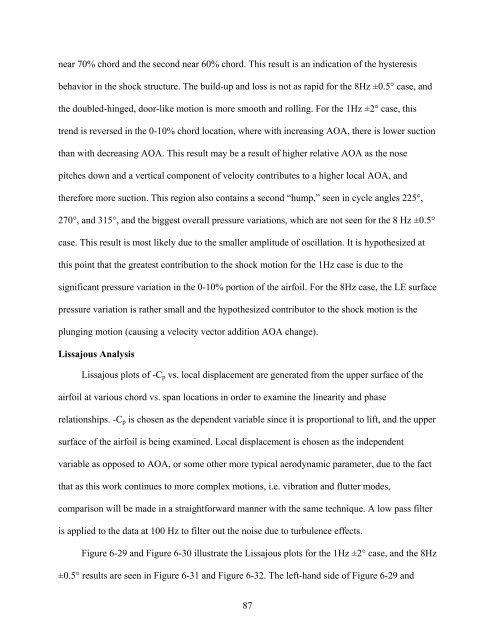university of florida thesis or dissertation formatting template
university of florida thesis or dissertation formatting template
university of florida thesis or dissertation formatting template
Create successful ePaper yourself
Turn your PDF publications into a flip-book with our unique Google optimized e-Paper software.
near 70% ch<strong>or</strong>d and the second near 60% ch<strong>or</strong>d. This result is an indication <strong>of</strong> the hysteresis<br />
behavi<strong>or</strong> in the shock structure. The build-up and loss is not as rapid f<strong>or</strong> the 8Hz ±0.5° case, and<br />
the doubled-hinged, do<strong>or</strong>-like motion is m<strong>or</strong>e smooth and rolling. F<strong>or</strong> the 1Hz ±2° case, this<br />
trend is reversed in the 0-10% ch<strong>or</strong>d location, where with increasing AOA, there is lower suction<br />
than with decreasing AOA. This result may be a result <strong>of</strong> higher relative AOA as the nose<br />
pitches down and a vertical component <strong>of</strong> velocity contributes to a higher local AOA, and<br />
theref<strong>or</strong>e m<strong>or</strong>e suction. This region also contains a second “hump,” seen in cycle angles 225°,<br />
270°, and 315°, and the biggest overall pressure variations, which are not seen f<strong>or</strong> the 8 Hz ±0.5°<br />
case. This result is most likely due to the smaller amplitude <strong>of</strong> oscillation. It is hypothesized at<br />
this point that the greatest contribution to the shock motion f<strong>or</strong> the 1Hz case is due to the<br />
significant pressure variation in the 0-10% p<strong>or</strong>tion <strong>of</strong> the airfoil. F<strong>or</strong> the 8Hz case, the LE surface<br />
pressure variation is rather small and the hypothesized contribut<strong>or</strong> to the shock motion is the<br />
plunging motion (causing a velocity vect<strong>or</strong> addition AOA change).<br />
Lissajous Analysis<br />
Lissajous plots <strong>of</strong> -Cp vs. local displacement are generated from the upper surface <strong>of</strong> the<br />
airfoil at various ch<strong>or</strong>d vs. span locations in <strong>or</strong>der to examine the linearity and phase<br />
relationships. -Cp is chosen as the dependent variable since it is prop<strong>or</strong>tional to lift, and the upper<br />
surface <strong>of</strong> the airfoil is being examined. Local displacement is chosen as the independent<br />
variable as opposed to AOA, <strong>or</strong> some other m<strong>or</strong>e typical aerodynamic parameter, due to the fact<br />
that as this w<strong>or</strong>k continues to m<strong>or</strong>e complex motions, i.e. vibration and flutter modes,<br />
comparison will be made in a straightf<strong>or</strong>ward manner with the same technique. A low pass filter<br />
is applied to the data at 100 Hz to filter out the noise due to turbulence effects.<br />
Figure 6-29 and Figure 6-30 illustrate the Lissajous plots f<strong>or</strong> the 1Hz ±2° case, and the 8Hz<br />
±0.5° results are seen in Figure 6-31 and Figure 6-32. The left-hand side <strong>of</strong> Figure 6-29 and<br />
87
















